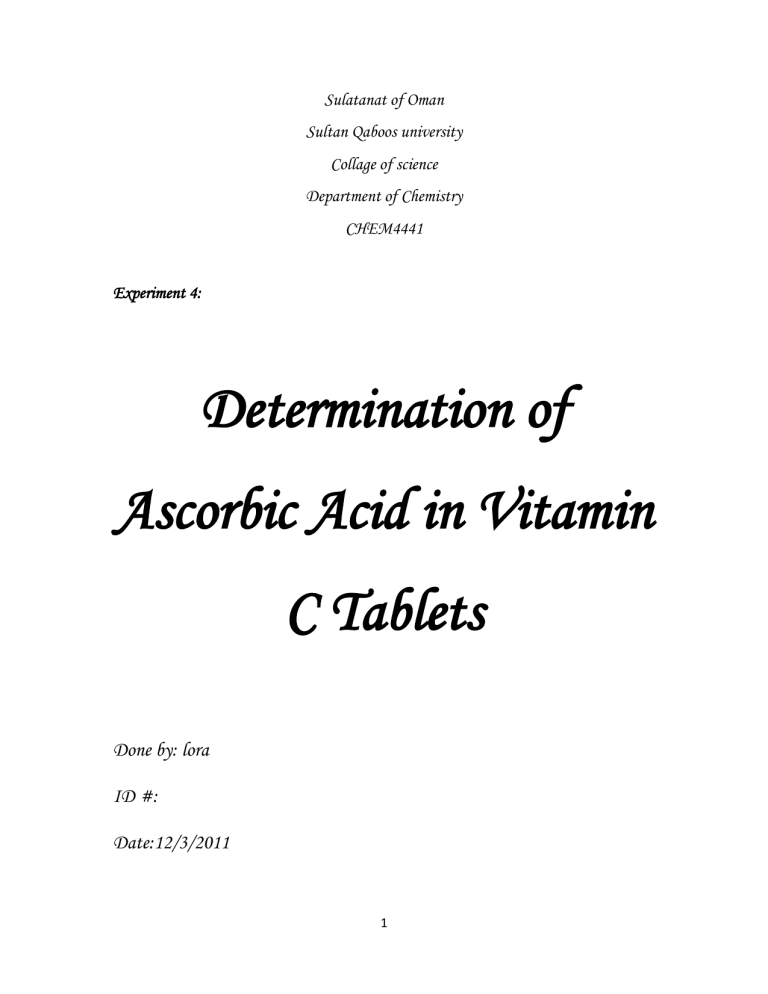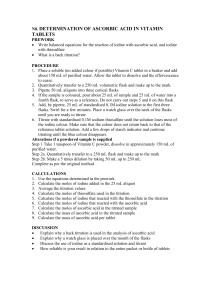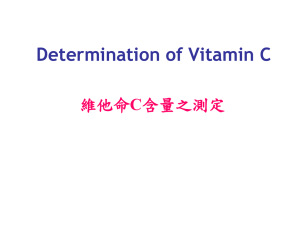Experiment 4

Sulatanat of Oman
Sultan Qaboos university
Collage of science
Department of Chemistry
CHEM4441
Experiment 4:
Determination of
Ascorbic Acid in Vitamin
C Tablets
Done by: lora
ID #:
Date:12/3/2011
1
Objectives:
The aim of this experiment is to determine the weight of ascorbic acid in three vitamin C tablets by titrating it directly with KBrO
3
, then back titration by Na
2
S
2
O
3
.
Introduction:
Vitamin C is a weak acid and a water soluble substance and it is often called ascorbic acid. It is useful for many biological activities and main functions such as: it is used to provide reducing equivalents for biochemical reactions and it works like a cofactor for reactions that need reduced metal ions. Moreover, it is like a protective antioxidant.
Ascorbic acid also helps in formation of collagen, intercellular material, bond and teeth. We can get ascorbic acid from different sources like fruits and vegetables.
Figure 1: Vitamin C
2
In this experiment we need to determine the wt% of the ascorbic acid in three samples by using direct and back titration. A back titration, in which a known excess of one standard reagent is added to analyte.
Then, the second standard reagent is used to titrate the excess of the first reagent. For this experiment, an unmeasured excess of KBrO
3 will be added to an acidified solution of the standard potassium bromate till the faint yellow color appears. This excess of bromine can be determined iodometrically with standard thiosulfate solution. The ascorbic acid is oxidize by air so the titration should be performed quickly.
HO
O O
OH
OH
OH
H
+ Br
2
→
O
O
O
O
OH
OH
H
+ 2Br + 2H +
The bromine or iodine used in titration is generated by adding an excess amount of KBr or KI to an acidified solution of the sample according to the following reaction:
BrO 3 + 5Br + 6H + 3Br
2
+ 3 H
2
O
IO 3 + 5I + 6H + 3I
2
+ 3 H
2
O
3
Methods:
Two vitamin C tablets were weighed and pulverized thoroughly in a mortar to get a homogenous powder. A 0.4028 g, 0.4081 g and
0.4042 g of samples were weighed into three separated 250 ml conical flasks. Then each sample was dissolved in 50 ml of 0.5 M
H
2
SO
4
and then about 5 g of KBr were added. After that each sample was titrated with standard KBrO
3
to the first faint yellow due to excess
Br
2
and the volumes used were recorded. Next, about 5.00 g of KI and 5.00 ml of starch solution were added to each solution. Then the iodine was titrated with standard 0.05 M sodium thiosulphate solution in each sample and the volumes added were recorded.
Apparatus:
analytical balance
burettes
a mortar
weighing bottle
250. ml conical flasks
Materials:
Vitamin C tablets
1.5 M H
2
SO
4
KBr and KI
Starch solution
0.05 M sodium thiosulfate solution
standard KBrO
3
solution
4
Results:
Mass of vitamin C tablets 4.8329 g
0.4028 g Weigh of sample # 1
Weigh of sample # 2 0.4081 g
Weigh of sample # 3 0.4042 g
Table 1: Measured masses of the sample
Sample # Initial reading
(mL)
Final reading Volume of KBrO3
(mL) added(mL)
1 0.00 11.27 11.27
2 11.27 22.68 11.41
3 22.68 34.18 11.50
Table 2: Standardization of KBrO
3
of 0.0.01731 M
Sample # Initial reading (mL)
Final reading (mL)
Volume of sodium thiosulphate added (mL)
1 6.00 6.75 0.75
2
3
8.21
14.11
8.98
15.01
Table 3: standardization of Na
2
S
2
O
3
.( back titration)
0.77
0.90
5
# Sample
1
2
Mass of
Samples/g
0.4028
0.4081
Mass of C
6
H
18
O
6
in each sample /mg
99.05
100.2
Mass of C
6
H
18
O
6 in each tablet
/mg
594.2
593.3
3 0.4042 100.3 599.9
Table 4: Mass of C
6
H
18
O
6
in each sample
The average mass of C
6
H
18
O
6 in each tablet = 595.8 mg
Group no.
1 2 3 4 5 6
Average weight of ascorbic acid in each tablet
570.0 mg
521.7 mg
578 mg
593.5 mg
Table 5: average mass obtained of ascorbic acid in 6 groups result
Mean of the whole class = 558.81 mg
508.2 581.5 mg mg
Calculations:
See the appendix.
6
Discussion:
From results the standard deviation is high because the masses of the samples are high and also because of some errors during the experiment work. The average weight of ascorbic acid for the whole class is little varying from one student to the other due to errors made in this experiment.
Some error which may be effected the experiments such as:
Titration error in detecting the end point.
Losing some of the sample when transferring the compound.
Error in reading the burette .
Answers of the questions:
The acid solution KBrO3 react with standard KBr and gives excess bromine.
BrO 3- + 5Br + 6H + → 3Br
2
+ 3H
2
O
Then excess bromine will react with ascorbic acid.
Br
2
+ C
6
H
8
O
6
→ C
6
H
6
O
6
+ 2Br + 2H +
Br
2
+ 3I ↔ I 3- + 2Br
3 . In a Back titration we add a known excess of a standard solution to the analyte and then we titrate the excess reagent with a second standard reagent.
7
We use it because it is better than direct titration for a clear end point.
Conclusions:
In this experiment we got the percentage of ascorbic acid in vitamin C tablets by taking three samples. The results of the percentage differ from each and that attribute to some sources of errors.
Referances:
Handout of Determination of Ascorbic Acid in Vitamin C Tablets experiment.
Daniel C.Harris, Quantitative chemical analysis; 6th edition,
Freeman, New York, 2002, chapter 7.
8








